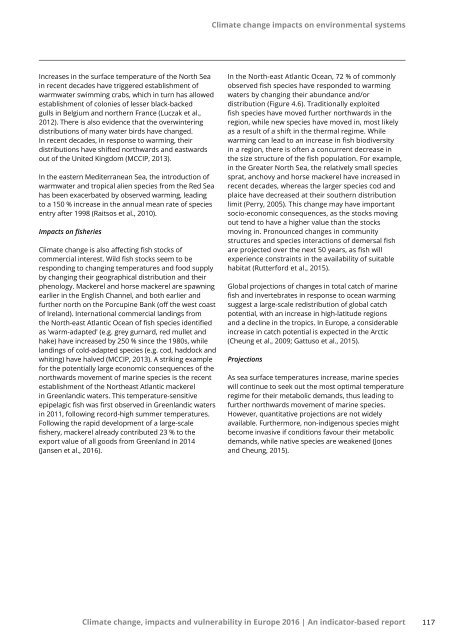Climate change impacts and vulnerability in Europe 2016
document
document
You also want an ePaper? Increase the reach of your titles
YUMPU automatically turns print PDFs into web optimized ePapers that Google loves.
<strong>Climate</strong> <strong>change</strong> <strong>impacts</strong> on environmental systems<br />
Increases <strong>in</strong> the surface temperature of the North Sea<br />
<strong>in</strong> recent decades have triggered establishment of<br />
warmwater swimm<strong>in</strong>g crabs, which <strong>in</strong> turn has allowed<br />
establishment of colonies of lesser black-backed<br />
gulls <strong>in</strong> Belgium <strong>and</strong> northern France (Luczak et al.,<br />
2012). There is also evidence that the overw<strong>in</strong>ter<strong>in</strong>g<br />
distributions of many water birds have <strong>change</strong>d.<br />
In recent decades, <strong>in</strong> response to warm<strong>in</strong>g, their<br />
distributions have shifted northwards <strong>and</strong> eastwards<br />
out of the United K<strong>in</strong>gdom (MCCIP, 2013).<br />
In the eastern Mediterranean Sea, the <strong>in</strong>troduction of<br />
warmwater <strong>and</strong> tropical alien species from the Red Sea<br />
has been exacerbated by observed warm<strong>in</strong>g, lead<strong>in</strong>g<br />
to a 150 % <strong>in</strong>crease <strong>in</strong> the annual mean rate of species<br />
entry after 1998 (Raitsos et al., 2010).<br />
Impacts on fisheries<br />
<strong>Climate</strong> <strong>change</strong> is also affect<strong>in</strong>g fish stocks of<br />
commercial <strong>in</strong>terest. Wild fish stocks seem to be<br />
respond<strong>in</strong>g to chang<strong>in</strong>g temperatures <strong>and</strong> food supply<br />
by chang<strong>in</strong>g their geographical distribution <strong>and</strong> their<br />
phenology. Mackerel <strong>and</strong> horse mackerel are spawn<strong>in</strong>g<br />
earlier <strong>in</strong> the English Channel, <strong>and</strong> both earlier <strong>and</strong><br />
further north on the Porcup<strong>in</strong>e Bank (off the west coast<br />
of Irel<strong>and</strong>). International commercial l<strong>and</strong><strong>in</strong>gs from<br />
the North-east Atlantic Ocean of fish species identified<br />
as 'warm-adapted' (e.g. grey gurnard, red mullet <strong>and</strong><br />
hake) have <strong>in</strong>creased by 250 % s<strong>in</strong>ce the 1980s, while<br />
l<strong>and</strong><strong>in</strong>gs of cold-adapted species (e.g. cod, haddock <strong>and</strong><br />
whit<strong>in</strong>g) have halved (MCCIP, 2013). A strik<strong>in</strong>g example<br />
for the potentially large economic consequences of the<br />
northwards movement of mar<strong>in</strong>e species is the recent<br />
establishment of the Northeast Atlantic mackerel<br />
<strong>in</strong> Greenl<strong>and</strong>ic waters. This temperature-sensitive<br />
epipelagic fish was first observed <strong>in</strong> Greenl<strong>and</strong>ic waters<br />
<strong>in</strong> 2011, follow<strong>in</strong>g record-high summer temperatures.<br />
Follow<strong>in</strong>g the rapid development of a large-scale<br />
fishery, mackerel already contributed 23 % to the<br />
export value of all goods from Greenl<strong>and</strong> <strong>in</strong> 2014<br />
(Jansen et al., <strong>2016</strong>).<br />
In the North-east Atlantic Ocean, 72 % of commonly<br />
observed fish species have responded to warm<strong>in</strong>g<br />
waters by chang<strong>in</strong>g their abundance <strong>and</strong>/or<br />
distribution (Figure 4.6). Traditionally exploited<br />
fish species have moved further northwards <strong>in</strong> the<br />
region, while new species have moved <strong>in</strong>, most likely<br />
as a result of a shift <strong>in</strong> the thermal regime. While<br />
warm<strong>in</strong>g can lead to an <strong>in</strong>crease <strong>in</strong> fish biodiversity<br />
<strong>in</strong> a region, there is often a concurrent decrease <strong>in</strong><br />
the size structure of the fish population. For example,<br />
<strong>in</strong> the Greater North Sea, the relatively small species<br />
sprat, anchovy <strong>and</strong> horse mackerel have <strong>in</strong>creased <strong>in</strong><br />
recent decades, whereas the larger species cod <strong>and</strong><br />
plaice have decreased at their southern distribution<br />
limit (Perry, 2005). This <strong>change</strong> may have important<br />
socio‐economic consequences, as the stocks mov<strong>in</strong>g<br />
out tend to have a higher value than the stocks<br />
mov<strong>in</strong>g <strong>in</strong>. Pronounced <strong>change</strong>s <strong>in</strong> community<br />
structures <strong>and</strong> species <strong>in</strong>teractions of demersal fish<br />
are projected over the next 50 years, as fish will<br />
experience constra<strong>in</strong>ts <strong>in</strong> the availability of suitable<br />
habitat (Rutterford et al., 2015).<br />
Global projections of <strong>change</strong>s <strong>in</strong> total catch of mar<strong>in</strong>e<br />
fish <strong>and</strong> <strong>in</strong>vertebrates <strong>in</strong> response to ocean warm<strong>in</strong>g<br />
suggest a large-scale redistribution of global catch<br />
potential, with an <strong>in</strong>crease <strong>in</strong> high-latitude regions<br />
<strong>and</strong> a decl<strong>in</strong>e <strong>in</strong> the tropics. In <strong>Europe</strong>, a considerable<br />
<strong>in</strong>crease <strong>in</strong> catch potential is expected <strong>in</strong> the Arctic<br />
(Cheung et al., 2009; Gattuso et al., 2015).<br />
Projections<br />
As sea surface temperatures <strong>in</strong>crease, mar<strong>in</strong>e species<br />
will cont<strong>in</strong>ue to seek out the most optimal temperature<br />
regime for their metabolic dem<strong>and</strong>s, thus lead<strong>in</strong>g to<br />
further northwards movement of mar<strong>in</strong>e species.<br />
However, quantitative projections are not widely<br />
available. Furthermore, non-<strong>in</strong>digenous species might<br />
become <strong>in</strong>vasive if conditions favour their metabolic<br />
dem<strong>and</strong>s, while native species are weakened (Jones<br />
<strong>and</strong> Cheung, 2015).<br />
<strong>Climate</strong> <strong>change</strong>, <strong>impacts</strong> <strong>and</strong> <strong>vulnerability</strong> <strong>in</strong> <strong>Europe</strong> <strong>2016</strong> | An <strong>in</strong>dicator-based report<br />
117


